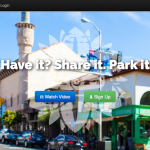How hearing impaired drivers work at Lyft
Out of the ongoing hubub over regulating rideshare companies emerges a positive new trend at ridesharing service Lyft: The company, recognizable for the giant pink mustache logos attached to its cars, is seeing an uptick in deaf hires. A number of sources have reported that deaf drivers using the app are on the rise, and, as Fox reported earlier this year, one sign language instructor has even been training deaf drivers to drive for Lyft.

Digital Army Devices founder Jibril Jaha showcasing his app, iseewhatyousay. From SFGate.
While Lyft did not provide concrete figures for the number of deaf drivers it has hired, reports CityLab, the company’s communications manager, Chelsea Wilson, notes that “The members of our driver community are the heart of what makes the Lyft experience unique… A number of these drivers are hearing-impaired and are able to take advantage of the flexibility and economic opportunity our platform provides.”
Lyft is flexible, for not just its passengers — who can order rideshares via a smartphone app — but also for drivers, who can pick their own hours and drive their own vehicles. The pay is respectable, too: The company says those working part-time can earn up to $35 hourly. Lyft drivers are required to be 21 years old and licensed to drive for at least one year prior to applying for the gig; they must also have in-state insurance and in in-state license, a clean driving record, and, of course, a car (which must also meet specific requirements, such as having four doors and at least five seatbelts).
Lyft can provide a welcome employment opportunity for a group that often faces unique challenges in the job market. Deaf workers can encounter issues from outright or indirect discrimination to difficulties interviewing for jobs without a sign language interpreter. As Mark Medina, a Modesto, California sign language teacher who trains deaf drivers to use the Lyft app, explained: “People would be pretty fortunate to have a Lyft ride with a deaf driver. It’s good exposure for the hearing and the deaf community, to bridge the gaps between the two, to not be too scared, not to be timid.”
One app, called I See What You Say, is also helping deaf Lyft drivers in their roles. Designed to assist deaf drivers communicate using technology with passengers who do not know sign language, the app allows passengers to speak into a smartphone, which then transcribes their words and sends the message to the driver’s special watch, where he or she can read it.
Deaf Lyft driver Jibril Jaha, whose startup company created the app, explained its significance to the San Francisco Chronicle: “This has transformed the way I communicate with hearing people. I can read lips, but it’s hard to do that while driving (or engaged in other activities). Writing things down takes too long. This really streamlines communications.”
Learn more about becoming a Lyft driver or Lyft passenger.
Related Posts
Category: Disability, Transportation

















